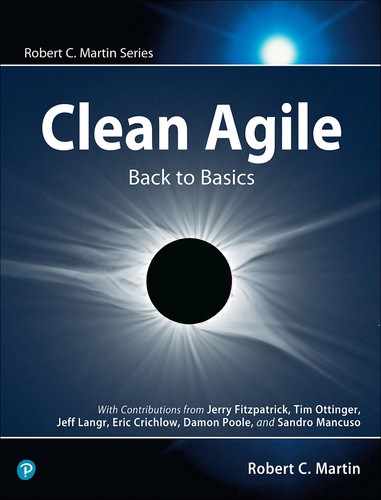Foreword
What exactly is Agile development? How did it originate? How has it evolved?
In this book, Uncle Bob provides thoughtful answers to these questions. He also identifies the many ways in which Agile development has been misinterpreted or corrupted. His perspective is relevant because he is an authority on the subject, having participated in the birth of Agile development.
Bob and I have been friends for many years. We first met when I joined the telecommunications division of Teradyne in 1979. As an electrical engineer, I helped install and support products; later, I became a hardware designer.
About a year after I joined, the company began seeking new product ideas. In 1981, Bob and I proposed an electronic telephone receptionist—essentially a voicemail system with call-routing features. The company liked the concept, and we soon began developing “E.R.—The Electronic Receptionist.” Our prototype was state of the art. It ran the MP/M operating system on an Intel 8086 processor. Voice messages were stored on a five-megabyte Seagate ST-506 hard disk. I designed the voice port hardware while Bob started writing the application. When I finished my design, I wrote application code, too, and I have been a developer ever since.
Around 1985 or 1986, Teradyne abruptly halted E.R. development and, unknown to us, withdrew the patent application. It was a business decision that the company would soon regret, and one that still haunts Bob and me.
Eventually, each of us left Teradyne for other opportunities. Bob started a consulting business in the Chicago area. I became a software contractor and instructor. We managed to stay in touch even though I moved to another state.
By the year 2000, I was teaching Object-Oriented Analysis and Design for Learning Tree International. The course incorporated UML and the Unified Software Development Process (USDP). I was well versed in these technologies, but not with Scrum, Extreme Programming, or similar methodologies.
In February 2001, the Agile Manifesto was published. Like many developers, my initial reaction was “The Agile what?” The only manifesto I knew of was from Karl Marx, an avid Communist. Was this Agile thing a call to arms? Dang software radicals!
The Manifesto did start a rebellion of sorts. It was meant to inspire the development of lean, clean code by using a collaborative, adaptive, feedback-driven approach. It offered an alternative to “heavyweight” processes like Waterfall and the USDP.
It has been 18 years since the Agile Manifesto was published. It is, therefore, ancient history to most of today’s developers. For this reason, your understanding of Agile development may not line up with the intent of its creators.
This book aims to set the record straight. It provides a historical lens through which to view Agile development more fully and accurately. Uncle Bob is one of the smartest people I know, and he has boundless enthusiasm for programming. If anyone can demystify Agile development, it’s him.
—Jerry Fitzpatrick
Software Renovation Corporation
March 2019
